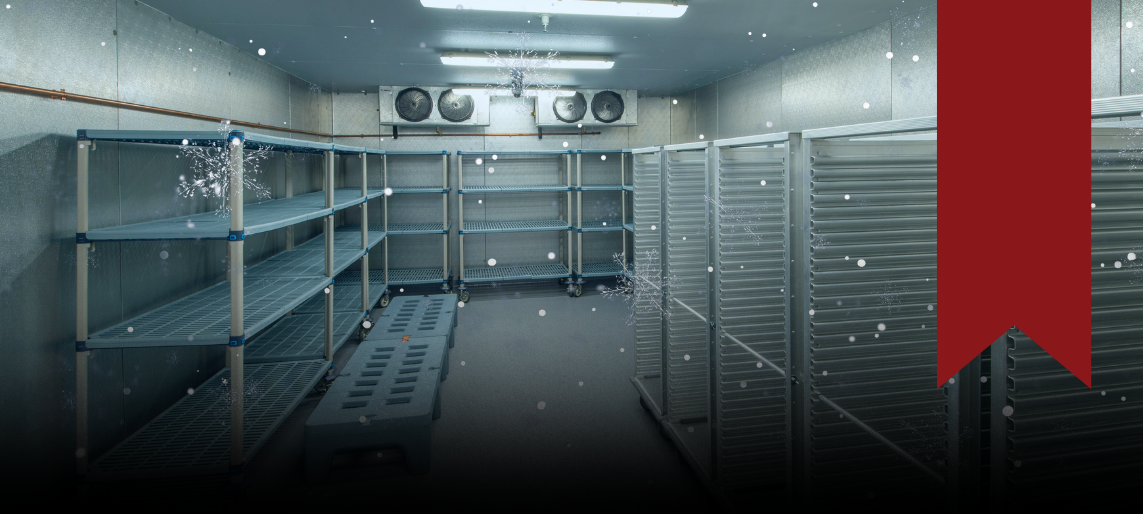
Summary
Summary:
Learn how much your walk-in cooler or freezer can hold, how to organize and load it safely, and how to spot warning signs before small issues become expensive repairs. This guide covers shelving (wire vs. plastic), airflow, cleaning, safety codes, and includes a downloadable walk-in responsibility checklist.
Understanding Walk-In Capacity
A walk-in cooler or walk-in freezer is more than cold storage — it’s a precision-controlled system that depends on proper organization, temperature balance, and maintenance.
Formula for total volume:
Length × Width × Height = Total Cubic Feet
Example: An 8′ × 10′ × 7′ walk-in = 560 cubic feet.
After shelving and clearance, usable space is about 60–70% — roughly 336–392 cubic feet.
Choosing the Right Shelving
Your shelving affects airflow, cleanability, and long-term reliability.
Wire vs. Plastic Shelving Comparison
Feature
Wire Shelving
Plastic (Polymer) Shelving
Air Circulation
Excellent – open grid promotes airflow.
Good – solid mats reduce airflow slightly.
Weight Capacity
600–800 lbs per shelf.
500–800 lbs per shelf.
Corrosion Resistance
Moderate – may rust if coating wears off.
Excellent – rust- and moisture-proof.
Cleaning
Wipes easily; may need frequent cleaning.
Removable mats often dishwasher-safe.
Longevity
High in dry conditions.
Very high in damp/freezer settings.
Cost
Lower upfront.
Higher upfront, lower maintenance.
Best Use
Kitchens, prep areas.
Freezers, seafood, or healthcare storage.
Pro Tip: Combine both — wire for airflow, plastic for wet zones or under evaporator fans.
Floor Load Limits and Heavy Carts
Walk-in floors handle distributed weight, not concentrated wheel loads. Rolling in heavy carts can crack floor panels, crush insulation, or trap moisture.
Rated for 600–800 lbs per sq. ft. distributed.
Avoid narrow casters — they concentrate pressure.
Use load plates or ramps for heavy carts.
Consider floorless construction on sealed concrete for frequent cart traffic.
OSHA 29 CFR 1910.22: Floors must remain dry, even, and free of hazards.
If a cart is difficult to roll, it’s probably too heavy for your walk-in floor.
How to Load and Store Items
Maintain Airflow: Keep 4–6 inches from walls and ceiling (FDA Food Code §3-501.16).
Avoid Overpacking: Overloading blocks airflow and reduces efficiency.
Store 6 inches off the floor: (§4-204.122).
Use Vertical Space Wisely: Heavy low, light high.
Follow FIFO: Rotate oldest stock forward.
- Zone by Product Type:
- Bottom: raw meat or seafood.Middle: dairy, sauces.Top: produce or beverages.
Avoid Door Areas: Temp fluctuates near doors.
Label and Use Clear Bins: Improves speed and accuracy.
Keep Aisles Clear: Minimum 18 inches for access and airflow.
Recognizing Warning Signs of Problems
Early detection prevents downtime, spoilage, and costly repairs.
Warning Sign
What It Means / What to Do
Frost or ice buildup
Door not sealing or overloaded airflow — check gaskets and vents.
Water pooling on floor
Drain clog or condensation problem — clean and report.
Uneven temperature
Blocked airflow or dirty condenser — reorganize and clean.
Door won’t close tightly
Worn gasket or hinge — clean or replace.
Loud or unusual noises
Fan or compressor strain — report to maintenance.
Persistent odors
Spillage, mold, or poor circulation — deep clean and sanitize.
Flickering lights
Moisture intrusion — replace fixture per NSF/ANSI 2.
Long compressor cycles
Dirty coils or air leaks — schedule service.

Rule: If it looks, sounds, or smells wrong, log it and notify maintenance immediately.
Cleaning and Sanitation Best Practices
Cleanliness ensures safety, energy efficiency, and compliance.
Daily
Wipe spills immediately using a food-safe cleaner.
Sanitize door gaskets and handles.
Check floor drains for clogs.
Weekly
Clean shelves, bins, and vents.
Inspect for frost, mold, or odors.
Confirm airflow behind products.
Monthly
Deep-clean behind shelving.
Mop with non-acidic, non-abrasive floor cleaner.
Clean light fixtures and replace cracked covers.
Quarterly
Schedule technician inspection (refrigerant, calibration, alignment).
Vacuum condenser coils.
Log all cleaning and maintenance per HACCP and OSHA.
Avoid bleach on metal and never pressure wash inside the walk-in.
Safety and Regulatory Compliance
NSF/ANSI Standards: Shelving and flooring must be food-safe and easy to clean.
FDA Food Code: Store food ≥ 6 inches off floors, ≤ 41°F for coolers, ≤ 0°F for freezers.
OSHA 29 CFR 1910: Keep surfaces dry and hazard-free.
EPA Section 608: Follow refrigerant rules.
NFPA 70 & 96: Apply to lighting and ventilation near kitchen spaces.
Bonus Storage & Efficiency Tips
Add strip curtains to retain cold air.
Replace cardboard boxes with washable bins.
Keep door gaskets clean to prevent leaks.
Install LED lights to save energy and reduce heat.
Track temperatures digitally for alerts.
Limit door-open time — every open minute adds up to 15 minutes of recovery time.
Remember: Clean • Cold • Clear — the three pillars of walk-in management.
FAQs
Q: How much can I store in my walk-in?
A: Roughly 60–70% of total cubic footage for safe airflow and efficiency.
Q: Which shelving is best?
A: Wire shelving for airflow and plastic shelving for corrosion resistance.
Q: What warning signs should I watch for?
A: Ice buildup, pooling water, or unusual noises — they all signal maintenance issues.
Q: How often should I clean my walk-in?
A: Wipe daily, sanitize weekly, deep-clean monthly, and service quarterly.
Q: What’s the correct temperature range?
A: Coolers: 35–38°F; Freezers: 0°F or below.









